With a population of nearly 350,000 (675,000 in the greater metropolitan area), Plovdiv is the second-largest city in Bulgaria after Sofia. It stands on the Maritsa River and is located southeast of Sofia, in a south-central part of the country, in the southern part of the fertile Plain of Plovdiv. As is also the claim of many other cities in the world (see Here), Plovdiv has historically developed on seven hills, some of which are 820 feet (250m) high.

Above: Composite image of Plovdiv’s Ancient Theatre (see further down the page)
There is evidence of people living where the city stands dating back to Neolithic times (in the 6th millennium BC) and has been considered to be one of the oldest cities in the world. Philip II of Macedon conquered the city in the 4th century BC and for much of its recorded history, the city was consequently known in the West by the name Philippopolis ("Philip's Town"). Invaded by Persians, Greeks, Celts, Romans, Goths, Huns, Bulgars, Slavs, Rus people, Crusaders, and eventually seized by the Turks in 1364, it remained under Turkish rule for 500 years, becoming part of Bulgaria in 1885. As a result of all this, the city has been given different names, throughout its colourful history.
The sites in the city featured on this webpage largely relate to two
periods of Plovdiv’s history, namely the Late Antiquity and the
Bulgarian Revival Period. During the late Antiquity, the millennial
Philippopolis was an important centre in Thrace, a Roman province
founded in 45 AD. Under the Romans, the city was considerably expanded,
making it the biggest trade centre in Thrace, with a population of
approximately 100,000. The city was a multicultural place, with many
large public and administrative buildings being erected, many still
preserved in one form or another, evidencing the prosperity of the city
during this period. Moving on to the Bulgarian Revival Period of the
18th- and 19th-centuries, the city underwent a period of economic,
political and cultural upheaval. There was a great national spirit that
affected all walks of life; in particular, the merchants and craftsmen
of Plovdiv reached out to developed foreign countries and cultures,
changing their style of life. New houses were constructed, and a new
vibrant life was brought back into the old town on the three central
historic hills.
The culture capital of Bulgaria, Plovdiv today is a major
transport, educational and economic centre; the city is home to Trakia
Economic Zone (TEZ), one of the largest industrial zones in Eastern
Europe.

Plovdiv hosts a large number of cultural events each year, including the International Fair Plovdiv, and has much to offer the visitor. With a city of this size and considerably rich in history, the points of interest featured here on this webpage are far from comprehensive and reflect the cultural and historical sites seen during a visit here in November 2019. The visit began at one of the city centre’s two tourist information centres at 1 D-r Stoyan Chomakov Str. in the Old Town (the other one being located at 1 Rayko Daskalov Str. at The Roman Stadium Square). From here, a selection of historic sites were visited during a walk around the Old Town, followed by a walk just to the south and then through Kapana (the Creative District), which is just west and adjacent to the Old Town. Below, we first look at the main cultural and historical sites seen during the walk, finishing with a final thumbnail gallery of other places seen during the visit. It may be worth noting here that walking around the Old Town involves negotiating uneven and hilly ground and so suitable footwear and a certain level of fitness should be taken into consideration, if sightseeing in this manner.
The House of Dr Sotir Antoniadi (Pharmacy Museum Hippocrates)
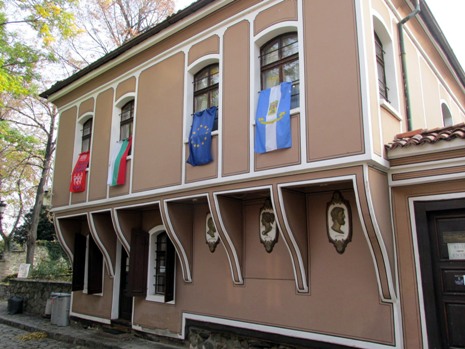 |
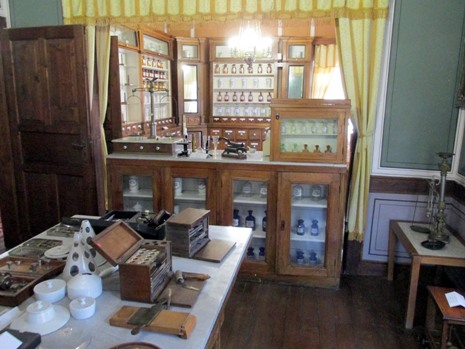 |
Shown above, The Pharmacy Museum Hippocrates is located in the House of Dr Sotir Antoniadi, which was built in 1872. Dr Antoniadi was among the first graduated doctors in Plovdiv. Since 1981, the house has hosted a museum exhibition for the history of pharmacy from the late 19th- and the early 20th-centuries and is the only museum of its type in Bulgaria. Although there was a pharmacy here from 1872, it ceased operating in 1947. The items on display illustrate how medicines at the time were entirely based on natural components, herbs, minerals and essential oils. Here, the most popular methods of remedy preparation which were used in the past can be seen.
Nebet Hill Archaeological Complex
The Nebet Hill (Nebet Tepe) Archaeological Complex is situated at the northern end of the Old Town. Here, traces of human activity found date back to the Stone-Copper Age (4th millennium BC) through to the present day (alas in the form of graffiti). Information on the earliest periods is scarce, although it is thought that at one point in time (12th- to 6th-centuries BC), a Thracian cult centre existed here. Evidence points to the presence of a Thracian settlement during the 5th- to 4th-centuries BC, although the expansion and flourishing of the settlement and its transformation into an urban centre is associated with the campaigns of Philip II in Thrace in 351 BC. It is likely that he strengthened the ridge of Nebet Hill for defence. As various occupations took place, the fortifications on the hill here (and in the city in the plain below) would have undergone various expansions, demolitions, repairs and upgrades. In the remains seen today, several major construction periods can be distinguished, namely Thracian (5th- to 1st-century BC), Roman (1st- to 4th-century AD), Early Byzantine ( 5th- to 6th-centuries), Middle Ages (9th- to 14th-centuries) and Ottoman (15th- to 19th-centuries). The name ‘Nebet Tepe’ is Turkish and means “watch tower”, reflecting its strategic importance for observing traffic on the Maritsa River below. As well as of strategic importance, it has been a sacred place (for the Thracians) and served as a place of residence. Some photos taken from Nebet Hill are shown in the thumbnail gallery below (click on an image to enlarge):
The Permanent Exposition of Zlatyu Boyadziev at the House of Dr Stoyan Chomakov
The House of Dr Stoyan Chomakov (below) was built in 1860. Dr Chomakov (1817-93) was an eminent public figure from the National Revival period and one of the most prominent advocates for an independent Bulgarian church. A surgeon, he studied medicine in Italy and in Paris and was the head of the first Bulgarian hospital, founded in Plovdiv after the Liberation.
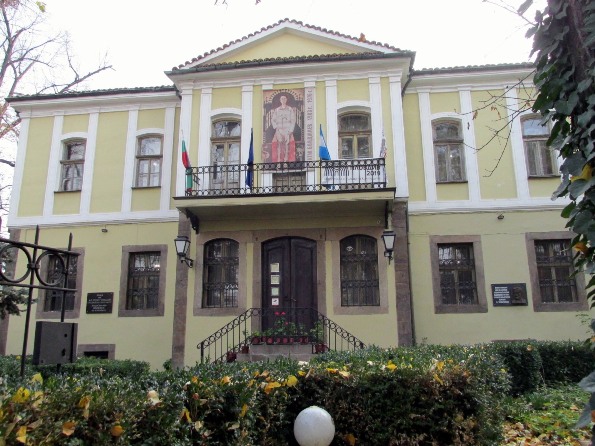 |
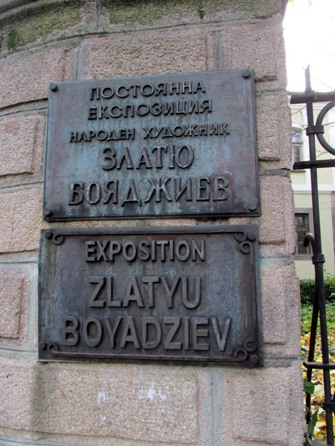 |
The house is a typical example of the late symmetrical Revival period houses with imposing architecture and interiors. Around the turn of the 20th century, the house was used as a summer residence of Tsar Ferdinand. Since 1984, the house has been used for a permanent exhibition for the largest collection of paintings by Bulgarian artist Zlatyu Boyadziev (1903-76).
The House of Hindliyan

Above: Composite image of The House of Stepan Hindliyan
The House of Stepan Hindliyan was built around 1835 by unknown master-builders. It is one of the few symmetrical houses in Plovdiv of the Revival period preserved in its original form. It is well-known for its unique decorative ornaments, including the preserved original wooden ceilings and wall paintings. The house’s owner founded one of the four most well-to-do Armenian families in the city and was a renowned merchant. His trade often took him to India in the early 19th-century and as a result of this, the name Hindlian was given to him. Lavish details cover the walls and ceilings; the painting of the wall details on the lower floor was created for the first time, using the paper-stencil technique. A steep staircase inside leads to the upper level, where the spacious hall, known under the Turkish word ‘hayet’, features a fountain which would have originally poured out rose water. The wall decorations include depictions of cities, including St. Petersburg, Athens, Venice and Constantinople (now Istanbul). The side rooms contain alafrangas – decorative alcoves serving to create the illusion of a window beyond which lies a landscape view. The house has a separate service wing and store room and above the door of the latter may be seen a mirror image of the house. Each year, several cultural events take place here, inside the house and its walled grounds. Some more photos of the house’s exterior, as well as its interior are shown in the thumbnail gallery below (click on an image to enlarge):
The Ancient Theatre
Plovdiv Roman Theatre was constructed in the 90’s of the 1st-century AD during the reign of Emperor Domitian, when Philippopolis , as it was then known, was under the ruler-ship of Titus Flavius Cotis. It is located at the southern end of the old town in the saddle between Taksim and Dzhambaz Tepe and had a capacity of about 5,000 spectators. The open-air seating area includes 28 concentric rows of marble seats. The three-storey building called scaenae frons is decorated with friezes, cornices, statues and Ionic and Corinthian colonnades. The theatre was used for hunter games and gladiator fights and was in use until the end of the 4th-century. Archaeological surveys were carried out from 1968-79 and at the end of this period, the theatre had been unearthed and partial conservation treatment carried out. Today, it is one of the world's best-preserved ancient theatres in the world and is still in use, hosting theatrical plays and musical shows during the summer months. As well as the photograph near the top of this page, some more photos of Plovdiv’s Ancient Theatre are shown in the thumbnail gallery below (click on an image to enlarge):
The Small Basilica
The Small Early Christian Basilica of Philippopolis with baptistery is an archaeological complex dating back to the 5th- to 6th-centuries AD. The basilica is located on Maria Louisa Blvd in the central part the city inside a modern protective building which also houses exhibits and two short informative films (shown back-to-back and available in English). The ruins of the early Christian church were found in 1988, during construction works in the area, revealing the building, which measured approximately 43 feet (13m) wide and 66 feet (20m) in length. The basilica was originally built as a three-nave structure with one apse and a narthex. A small chapel was built against the southern end of the basilica and the baptistery was attached to its northern side. Although only low walls of the structure remain, the three-nave basilica still retains a remarkable example of fine polychromatic floor mosaics, produced by the highly-skilled craftsmen of ancient Philippopolis. The structure contained rich architectural decoration, including a marble colonnade between the naves, a pulpit, a marble altar screen, and a synthronon in the altar apse (a synthronon is a structure in a church combining the bishop's throne and clergy stalls placed behind the altar against the east wall). Photographs from a visit to the site are shown in the final large thumbnail gallery lower down on this page (photos 83-86 & 89-100), whist photographs of the mosaics may be found on Wikipedia Here.
The Roman Stadium
The Roman Stadium in Plovdiv was constructed in the beginning of the 2nd-century AD, during the reign of Emperor Hadrian. It is located between the western slope of Taximtepe and the eastern slope of Sahattepe and would have been one of the most imposing buildings in Philippopolis during its heyday. It measured approximately 165 feet (50m) in width by 790 feet (240m) long and could seat up to 30,000 spectators. The white marble seating is tiered in 14 rows, crossed by stepped aisles running down to the track. Today, only the northernmost part of the stadium can be seen, after it was excavated in the 1970’s. It is possible to walk in a preserved part of the ancient street, see parts of the track, a section of the seating and a painted panorama which depicts the view towards the rest of the ancient stadium, as it would have appeared. Also here, is a section of ht e fortress wall, which was constructed during the reign of Marcus Aurelius in 172, as well as foundations from an aqueduct. As well as seeing these ancient structures, visible below the city’s street level, a small theatre for visitors shows a short 3D video about the history of the Roman Stadium and reconstructs some of the sporting events/games which would have taken place here. Photographs of Plovdiv’s Roman Stadium are shown in the thumbnail gallery below (click on an image to enlarge):
Forum of the Philippopolis
Walking around the city, there are numerous places where ancient ruins are either freely on show, or (at the time of the visit) seemingly undergoing excavations. One of the sites, belonging to the former category is the Forum of the Philippopolis, shown here:
 |
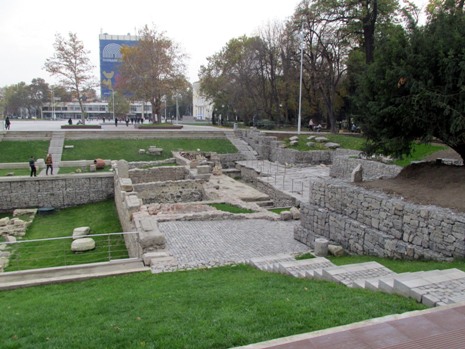 |
|
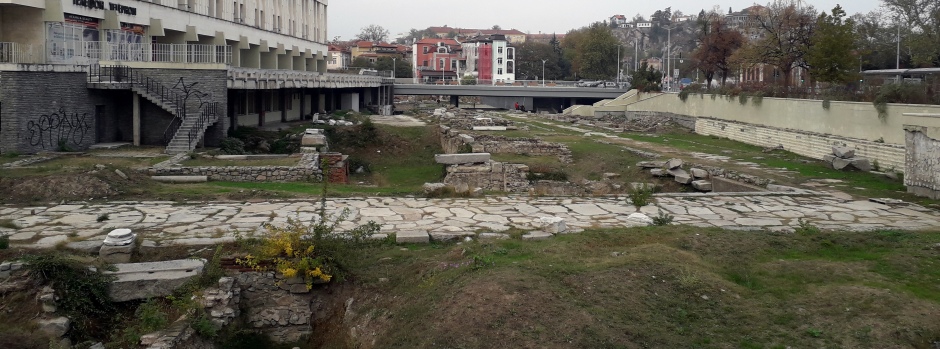 |
||
Today, located south of the old town on Plovdiv’s Central Square, the Roman Forum of Philippopolis was a rectangular-shaped plaza which was situated at the very centre of the ancient city. It would have formed the centre of public, administrative, commercial and religious life here and would have been surrounded by several administrative buildings which can be seen today as preserved ruins. Meetings, social gatherings, celebrations and official events were held here. The square today, whilst still maintaining its role as a focal point and meeting place for locals, is marked by the large multi-functional Central Post Office building (photos 137 & 139-142 in the final thumbnail gallery, below). Whilst the author here is a fan of Brutalistic architecture and rather liked this large concrete monolith, others may beg to differ, invariably describing it as imposing, having a massive Soviet look, a Communist block, a carbuncle and just plain ugly.
Back to the Roman Forum of Philippopolis; The ancient city centre was constructed according to a Roman model in the 1st-century AD, during the reign of Emperor Vespasian. The city’s forum was located in the centre, fixed by the crossing point of the two main streets, Cardo Maximus (north-south direction and Decumanus Maximus (east-west direction). Running parallel to these two main streets were numerous other cardi and decumani, forming a grid of rectangles known as insulae (Cardo was the Latin name given to a north-south street in Ancient Roman cities, and Decumanus east-west). Philippopolis’ forum covered an area of some 20 hectares (50 acres), although today just 11 hectares (27 acres) are visible. Insulae were created to the south, southeast and southwest of the forum, whilst to the north, the main public buildings were erected in the 2nd-century AD, at the site of the city’s three central hills. These public buildings would have been imposing structures and included The Odeon of Philippopolis (the house of the city council of citizens; seen centre right in photo 125 of the final thumbnail gallery lower down the page), The Treasury, The Ancient Stadium (see previous section) and The Thermae (large bath complexes).
Other Sites in Plovdiv
Other cultural and historical sites of interest in Plovdiv include the Balabanov House (reconstructed in 1976-79), The House of Nedkovich (built in the 1860’s), The House of Stambolyan (an imposing and richly decorated Revival house built in the second half of the 19th-century and home to a permanent exhibition of works by Plovdiv painter Dimitar Kirov-DiKiro (1935-2008)), the Klianti House (noted for its mural paintings and polychrome ceilings), the Lamartin House (built in 1829-30 and representative of the Plovdiv symmetrical house), the Bishop’s Basilica, the East Gate of the Philippopolis, the Bakalova House (with its craft centre) and the Old Town’s “Street of Crafts”.
Above: A view of the Maritsa River from the southern end of the city’s indoor pedestrian bridge. The bridge itself is lined with shops, effectively forming a long indoor mall over the river.
Plovdiv has an abundance of museums and these include the Regional Ethnographic Museum, the Regional Archaeological Museum, the Regional Natural History Museum, the Regional History Museum and the City Art Gallery, with the latter two to be found at multiple sites across the city. Cultural institutes include the Ancient Plovdiv Municipal Institute, the Municipal Foundation ‘Plovdiv 2019’, theatres, the Plovdiv State Opera, the ‘Boris Hristov’ City Hall of Culture and the ‘Ivan Vazov’ Public Library. Religious buildings include a large number of churches, the Roman Catholic Cathedral of St Louis (Sv. Ludvig), the Zion Plovdiv Synagogue, and two mosques. Green spaces include Tsar Simeon’s Garden, the City Garden (Dondukov Garden), Danov Hill and Liberators Hill.
As mentioned earlier on this page, the final thumbnail gallery on this page shows some of the other places seen during the visit to this cultural gem of a city (click on an image to enlarge):
References and Further Information
1. In Situ Literature and Information Boards
2. Bousfield,
J. and Richardson, D. (1996). Bulgaria. London: Rough Guides.
3. Carney, P. and Anastassova, M. (1998).
Bulgaria: Sofia and Plovdiv.
Sofia: PMC/Meri Anastassova-97.
4. Ward, P. (1989). Bulgaria: A
Travel Guide. Cambridge: Oleander.
Back to Top